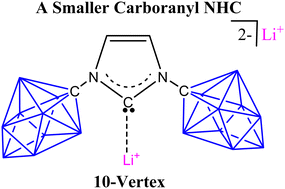Fusing 10-vertex closo-carborane anions with N-heterocyclic carbenes†
Abstract
Discovered by Knöth in 1964, the 10-vertex closo-carborane anion [HCB9H91−] is a classical bicapped square antiprism that contains an unusual pentacoordinate carbon center. Compared to its larger icosahedral cousin [HCB11H111−], few investigations have been made into its use as a weakly coordinating anion or as a ligand substituent. Here we show that it is possible to prepare both a dianionic N-heterocyclic carbene (NHC) Li+ adduct as well as a trianionic C-2, C-5 dilithio species featuring two 10-vertex carborane anion substituents. All compounds were characterized via multinuclear NMR spectroscopy, single crystal X-ray diffraction, and HRMS when possible.

- This article is part of the themed collection: 2022 Pioneering Investigators


 Please wait while we load your content...
Please wait while we load your content...